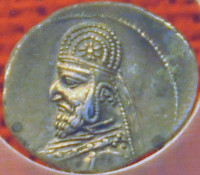Arsaces XII, Sinatruces
Arsaces XII, Sinatruces: Arsacid rebel king during a brief "dark period" in the history of the Parthian Empire (r.93/92-88/87 and 76-70/69).

The rule of the Parthian king Mithradates II had been very successful: he had secured the northeastern border, had invaded Armenia, had conquered all land east of the Euphrates, had concluded a friendship treaty with the Roman Republic, and had stimulated the economy. Few rulers had achieved so much. Yet, towards the end of his reign, there were domestic problems, which are poorly understood. Scholars call this the "dark period" in Parthian history, which lasted about three decades.
His relative Sinatruces had revolted in Elam in 93/92 and proclaimed himself king when he learned of Mithradates' death in 91 BCE. It was left to Mithradates' son Gotarzes I, the real successor, to suppress the insurrection. It took him five years, until the winter of 88/87.
This was not the end of the matter, however, because after the reign of Orodes I (r.80-75), he returned, perhaps supported by the Sacae. It is not known whether his return caused the downfall of Orodes, or whether he seized an opportunity after Orodes' death. In any case, the beginning of Sinatruces' second reign coincided with that of the little-known Arsaces XVI (r.75-62/61).
During Sinatruces' second reign, which lasted until 70 BCE, he refused to support Tigranes II of Armenia in his war against Rome.
Phraates III was a son of Sinatruces.
Note
The chronology of the Arsacid kings of the Parthian Empire is less well-understood than, for example, the sequence of Seleucid and Ptolemaic kings or the emperors of Rome. This information is based on the researches by G.R.F. Assar, as published in "Iran under the Arsakids, 247 BC – AD 224/227" in: Numismatic Art of Persia (2011).